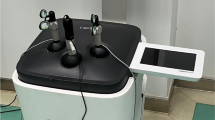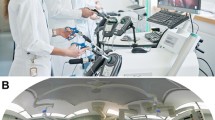Abstract
Background
Frequently medical students have to fulfill the role as the camera operator in laparoscopic procedures. Published work concerning camera navigation skills, especially in medical students, is rare. Therefore, our purpose was to evaluate personal characteristics and abilities that may affect virtual-reality laparoscopic camera navigation (VR-LCN) performance in a large cohort of first-time virtual-reality laparoscopy users.
Methods
First-time virtual-reality laparoscopy users (n = 488) were enrolled prospectively. The tasks included VR-LCN using a 0° and 30° angled laparoscope separately. Scores were correlated with demographics and students’ self-assessment in univariate and multivariate analyses.
Results
Six variables were associated with better VR-LCN results in the univariate analysis. On multivariate analysis, only male gender (odds ratio 2.3, 95 % confidence interval 1.4–3.9; p = 0.002) and higher self-confidence to assist in a laparoscopic operation (odds ratio 1.7, 95 % confidence interval 1.1–2.6; p = 0.014) were identified as predictive factors for a better 30° angled VR-LCN performance.
Conclusions
Our study indicates that medical students’ self-confidence regarding their ability to navigate a camera in a laparoscopic procedure and male gender predict a better first-time VR-LCN performance. These findings may provide a basis for a tailored educational approach.




Similar content being viewed by others
References
Becker T (1989) Kurzgefasster Operationskurs. Johann Ambrosius Barth, Leipzig
Conrad J, Shah AH, Divino CM, Schluender S, Gurland B, Shlasko E, Szold A (2006) The role of mental rotation and memory scanning on the performance of laparoscopic skills: a study on the effect of camera rotational angle. Surg Endosc 20:504–510
Korndorffer JR Jr, Hayes DJ, Dunne JB, Sierra R, Touchard CL, Markert RJ, Scott DJ (2005) Development and transferability of a cost-effective laparoscopic camera navigation simulator. Surg Endosc 19:161–167
Bennett A, Birch DW, Menzes C, Vizhul A, Karmali S (2011) Assessment of medical student laparoscopic camera skills and the impact of formal camera training. Am J Surg 201:655–659
Buzink SN, Botden SM, Heemskerk J, Goossens RH, de Ridder H, Jakimowicz JJ (2009) Camera navigation and tissue manipulation; are these laparoscopic skills related? Surg Endosc 23:750–757
Franzeck FM, Rosenthal R, Muller MK, Nocito A, Wittich F, Maurus C, Dindo D, Clavien PA, Hahnloser D (2012) Prospective randomized controlled trial of simulator-based versus traditional in-surgery laparoscopic camera navigation training. Surg Endosc 26:235–241
Shetty S, Panait L, Baranoski J, Dudrick SJ, Bell RL, Roberts KE, Duffy AJ (2012) Construct and face validity of a virtual reality-based camera navigation curriculum. J Surg Res 177(2):191–195
Stefanidis D, Haluck R, Pham T, Dunne JB, Reinke T, Markley S, Korndorffer JR Jr, Arellano P, Jones DB, Scott DJ (2007) Construct and face validity and task workload for laparoscopic camera navigation: virtual reality versus videotrainer systems at the SAGES learning center. Surg Endosc 21:1158–1164
Yee KA, Karmali S, Sherman V (2009) Validation of a simple camera navigation trainer. J Am Coll Surg 209:753–757
Buzink SN, Christie LS, Goossens RH, de Ridder H, Jakimowicz JJ (2010) Influence of anatomic landmarks in the virtual environment on simulated angled laparoscope navigation. Surg Endosc 24:2993–3001
Buzink SN, Goossens RH, Schoon EJ, de Ridder H, Jakimowicz JJ (2010) Do basic psychomotor skills transfer between different image-based procedures? World J Surg 34:933–940
van Dongen KW, Ahlberg G, Bonavina L, Carter FJ, Grantcharov TP, Hyltander A, Schijven MP, Stefani A, van der Zee DC, Broeders IA (2011) European consensus on a competency-based virtual reality training program for basic endoscopic surgical psychomotor skills. Surg Endosc 25:166–171
Naylor RA, Hollett LA, Castellvi A, Valentine RJ, Scott DJ (2010) Preparing medical students to enter surgery residencies. Am J Surg 199:105–109
Naylor RA, Hollett LA, Valentine RJ, Mitchell IC, Bowling MW, Ma AM, Dineen SP, Bruns BR, Scott DJ (2009) Can medical students achieve skills proficiency through simulation training? Am J Surg 198:277–282
Schlitzkus LL, Schenarts KD, Schenarts PJ (2010) Is your residency program ready for Generation Y? J Surg Educ 67:108–111
Paschold M, Schroder M, Kauff DW, Gorbauch T, Herzer M, Lang H, Kneist W (2011) Virtual reality laparoscopy: which potential trainee starts with a higher proficiency level? Int J Comput Assist Radiol Surg 6:653–662
Kneist W, Paschold M, Gockel I, Lang H (2012) Virtuelles Laparoskopietraining in der chirurgischen Weiterbildung. Spielerei oder curriculare Notwendigkeit? Passion Chirurgie 5:19–24
Gockel I, Hakman P, Beardi J, Schutz M, Heinrichs W, Messow CM, Junginger T (2008) New perspectives in laparoscopic simulation: from students’ skills lab to stress evaluation. Zentralbl Chir 133:244–249
Andreatta PB, Woodrum DT, Birkmeyer JD, Yellamanchilli RK, Doherty GM, Gauger PG, Minter RM (2006) Laparoscopic skills are improved with LapMentor training: results of a randomized, double-blinded study. Ann Surg 243:854–860
Ganai S, Donroe JA, St Louis MR, Lewis GM, Seymour NE (2007) Virtual-reality training improves angled telescope skills in novice laparoscopists. Am J Surg 193:260–265
Kimura D (1992) Sex differences in the brain. Sci Am 267:118–125
Thorson CM, Kelly JP, Forse RA, Turaga KK (2011) Can we continue to ignore gender differences in performance on simulation trainers? J Laparoendosc Adv Surg Tech A 21:329–333
Elneel FH, Carter F, Tang B, Cuschieri A (2008) Extent of innate dexterity and ambidexterity across handedness and gender: implications for training in laparoscopic surgery. Surg Endosc 22:31–37
Madan AK, Harper JL, Frantzides CT, Tichansky DS (2008) Nonsurgical skills do not predict baseline scores in inanimate box or virtual-reality trainers. Surg Endosc 22:1686–1689
Rosenthal R, Gantert WA, Scheidegger D, Oertli D (2006) Can skills assessment on a virtual reality trainer predict a surgical trainee’s talent in laparoscopic surgery? Surg Endosc 20:1286–1290
Engels PT, de Gara C (2010) Learning styles of medical students, general surgery residents, and general surgeons: implications for surgical education. BMC Med Educ 10:51
Windsor JA, Diener S, Zoha F (2008) Learning style and laparoscopic experience in psychomotor skill performance using a virtual reality surgical simulator. Am J Surg 195:837–842
Rogers DA (2002) Ethical and educational considerations in minimally invasive surgery training for practicing surgeons. Semin Laparosc Surg 9:206–211
Saalwachter AR, Freischlag JA, Sawyer RG, Sanfey HA (2005) The training needs and priorities of male and female surgeons and their trainees. J Am Coll Surg 201:199–205
Stone RJ (2011) The (human) science of medical virtual learning environments. Philos Trans R Soc Lond B Biol Sci 366:276–285
Acknowledgments
Supported in part by a grant from the medical education project “MAICUM” from the University Medicine of the Johannes Gutenberg-University and supported by the BMBF-funded IZKS/CHIR-NetMainz 01KN1103/01GH1001B.
Disclosures
Drs. Paschold, Niebisch, Kronfeld, Herzer, Lang, and Kneist have no conflicts of interest or financial ties to disclose.
Author information
Authors and Affiliations
Corresponding author
Rights and permissions
About this article
Cite this article
Paschold, M., Niebisch, S., Kronfeld, K. et al. Cold-start capability in virtual-reality laparoscopic camera navigation: a base for tailored training in undergraduates. Surg Endosc 27, 2169–2177 (2013). https://doi.org/10.1007/s00464-012-2735-0
Received:
Accepted:
Published:
Issue Date:
DOI: https://doi.org/10.1007/s00464-012-2735-0




